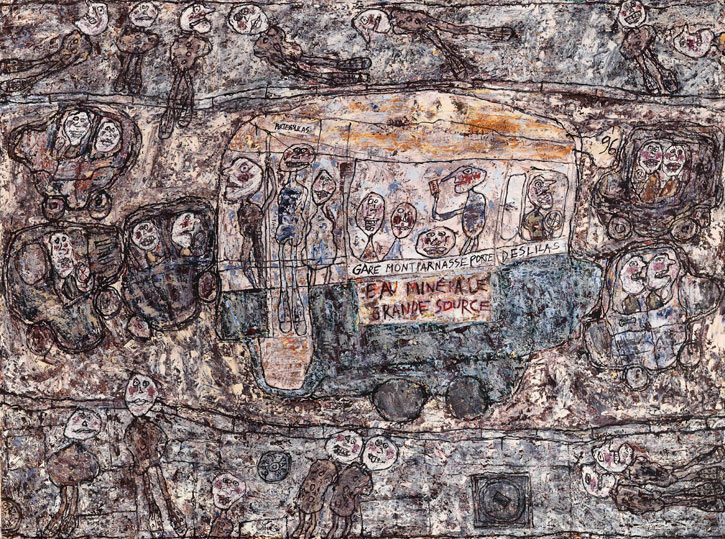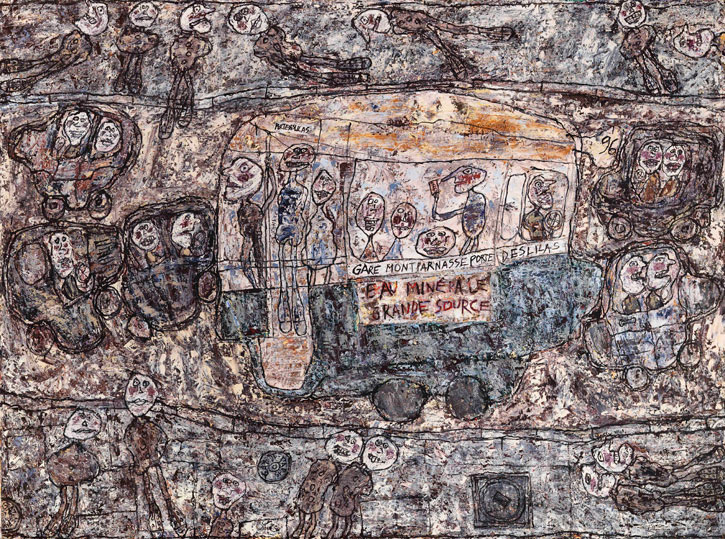by Fraser Hibbitt for the Carl Kruse Arts Blog
Sometime in the 1940s, the artist Jean Dubuffet coined the term “Art Brut” which roughly translates as “Raw art”; un-cooked and close to the initial mood of creation; or, the closest representation of the individual’s creative urge before the influence of learning. Much of Modernist art had been playing with this theme and had been courageously trying to get over the hump of earlier academic training, or taking steps to create a new one. In the opening decades of the twentieth century, questions of style and representation were caught between all those -isms that populate that fertile period. Picasso speaks about how he learned to see like a child; ‘Der Blaue Reiter’, in their only publication, showed an enthusiasm for “naïve” forms of folk art; Dadaism made its point of no-point while Surrealism automatism was nearing the surface.
The nineteenth-century academic artistic standards that had provoked rebellions lived on through those initial rebellions. Authority presumes opposition, and it is because of its relative stability that it provides an energetic ground for creation. The nineteenth-century judges of “fit aesthetics” provided a proven ground of what later artists could rebuff, and gave them an idea of what subject and style would not only shock public taste, but were still rude, still waiting to be expressed – so, in a sense, they lived on through opposition. When Picasso reviewed his plan for ‘Les Demoiselles d’Avignon’, he decided to nullify any sense of perspective and model the faces on African masks, giving the audience those sharp, cutting glares of an art form that had found the traditional Western forms of representation wanting; perception had been altered from the previous century, so they say, but in that painting, what was also being expressed? Rebellion, alteration, vigor of the artist, an intellectual/cultural conversation about expression? A want of recognition?

Pablo Picasso, Les Demoiselles d’Avignon, 1907
The keyword for the purpose of this essay is “found”. Most Modernist artists and the -isms all knew the traditional forms and were searching far afield to find new expressions. What these breaks and rebellions symbolize is a complex of ideas about aesthetics within a tradition. Modernism was working on two fronts in order to change perception, one through freeing the visible expression and the other through forcing reflection in how we perceive – and they knew what the critic, the art enthusiast, already knew or expected. Mainstream modernism was a cultural duel, and Art historians are quite confident in their abilities to see the rise and fall.
“Art Brut”, or what has been called “Outsider Art”, was (still is?), an art form that has not “found” anything in any artistic canon wanting because it has not supposedly been influenced by culture. Dubuffet was particularly interested in a psychiatric study by Hanz Prinzhorn: Artistry of the Mentally Ill (1922). In the study, Prinzhorn studied ten, of what he called, “schizophrenic Masters”. Most of the subjects displayed a spontaneous irruption of artistic delight and seemed to present an image of “raw” feeling in the treatment of their craft. Many of the Masters had led usual working lives before being hospitalized for the sudden onset of schizophrenic tendencies – this study of Prinzhorn was also the birth of “psychiatric art”, which would later result in Art therapy.
It was not only the art that came out of the psychiatric ward that interested Dubuffet. He also took an interest in the drawings of children, and of spiritualists and hermits. What binds these artists in Dubuffet’s eyes is their unassuming desire to create, their lack of concern for reward or appreciation, and their supposed lack of cultural knowledge and artistic tradition – this last reason is harder to qualify. All these variables cause hesitation, planning, and a degree of self-consciousness that inhibits the initial impulse and follow-through – two things that, by the 1940s, Dubuffet desired more than carrying on the Modernist experiments.

These “works from solitude” were for Dubuffet an analgesic. To stand a piece of “Art Brut” beside any work of “cultural” art was to see the paling of society; the intuitive power and unabashed presence of Art Brut next to a cultural composition shallowly vying for our attention. Excited and enthused by his discoveries, an art form that had not been swallowed by culture and thus choking off its genuine expression, Dubuffet set up the ‘Compagnie de l’Art Brut’ with leading Surrealist André Breton. The aim was to exhibit, discover, and document, the plains of outsider art. The movement lasted three years before being turned into a more commercially viable ‘Collection de l’Art Brut’.
Dubuffet himself, as you would expect, turned to a style of painting that was more simplistic, supposedly less concerned with intellectual matters, though how he spoke about his art remained intellectually refined. Did Dubuffet kill the authenticity he felt was in Art Brut by championing it, studying it, and trying to embody it? Is the one-sidedness of his argument convincing: culture, academic artistic culture (even with Modernist influence) = stifling, pretentious vs. art created outside these boundaries, at the expense of experience, in the case of the child, or at the expense of sanity = authentic. The authentic would never appear so without its other half.
Art Brut leaves the question of authenticity unanswered, and it is fine that it does: antipathies and sympathies drive the artist along. When the question of authenticity arises, the artist often will go “out of the common way” to bring something new into a culture. How does it sit when it is established? Must authenticity mercilessly create and destroy itself to be renewed? It’s true, the Art Brut of August Netter, or Adolf Wölfli, is fascinating and brilliant, and perhaps there is something to be gleaned: the abandonment of pretension, the utter giving up of one’s body to expression, the delight of play. What Dubuffet found so vital in Art Brut was the spirit and the necessity of art, something akin to what we feel finding in our heritage the caves of Altamira and Lascaux.
==========
The Carl Ktuse Arts Blog homepage is at https://carlkruse.net
Contact: carl AT carlkruse DOT com
The blog’s last post was on Comic Kids.
Other articles by Fraser Hibbitt include Thoughts on Science Fiction, the Street Art of Insane 51, and the Art of Atari.
A Carl Kruse Blog on technology and internet culture is here.
I like this idea of abandoning pretension.